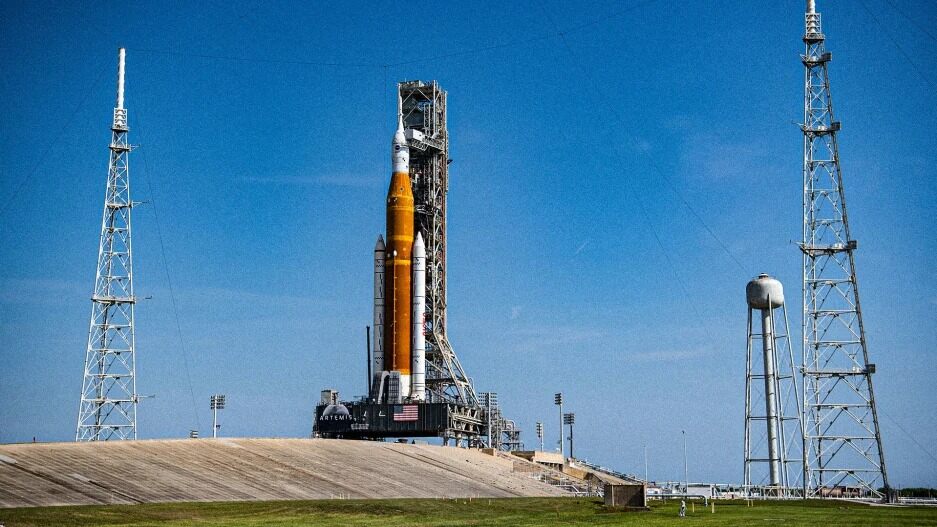- | 12:00 pm
NASA’s Artemis mission hopes to bring humans back to the moon—this time, to stay
On August 29, NASA will launch the first phase of landmark lunar expedition.

On the morning of August 29, hours after sunrise, NASA’s gigantic Space Launch System (SLS) moon rocket will blast off from the Atlantic coast, bound for lunar orbit. Perched on top of the rocket: the Orion astronaut capsule, destined to carry humans to the moon for the first time since 1972.
This time, there will be no humans on board. But the mission, dubbed “Artemis I,” will be the first test flight of the shuttle designed to propel us toward the stars. The 322-foot-long SLS rocket—which stands taller than the Statue of Liberty—will take off from the Kennedy Space Center in Florida, then circle the dark side of the moon, where no astronaut has ever flown before. After a 42-day voyage, it will splash down into the ocean.
Its success could pave the way for the most ambitious moon expedition in decades. If all goes well, NASA hopes to send humans into lunar orbit on its next mission, “Artemis II,” by 2024, followed by a lunar landing on “Artemis III” by 2025—when boots will step foot on the moon’s crust for the first time in half a century, including those of the first woman astronaut and astronaut of color to do so. (Once in space, the Orion pod, designed by Lockheed Martin, will break off from the SLS rocket and rendezvous with another spacecraft, designed by SpaceX, that will lower the astronauts onto the lunar surface.)
But unlike last time, NASA is now looking beyond the moon and even further into the universe. Artemis’s ultimate aim is to establish a sustainable lunar outpost as a stepping stone to one day land the first humans on Mars.
Named for the moon goddess of ancient Greek mythology, the missions will be the dawn of a new era, NASA administrator Bill Nelson said at a briefing in early August. “This is now the Artemis generation,” he told the crowd. “We were in the Apollo generation, but this is a new generation, this is a new type of astronaut. And to all of us that gaze up at the moon, dreaming of the day humankind returns to the lunar surface, folks, we’re here. We are going back and that journey, our journey, begins with Artemis I.”
Artemis will be ferrying precious cargo, even if no living beings. Three mannequins will be strapped on board, including Moonikin Campos in the commander’s seat, named for Arturo Campos, a NASA electrical engineer who helped bring Apollo 13 safely back to Earth after the shuttle’s oxygen tank exploded. The dummies will be dressed in spacesuits and flesh-like soft tissue, equipped to measure radiation levels.
An Amazon Alexa will also be present in the cabin in order to test whether it can respond to queries and verbal commands from mission control.
Finally, the crew will include two beloved members: a plush Snoopy, the comic strip dog that creator Charles M. Schulz had drawn as a moon astronaut in the Apollo days. Dressed in an orange spacesuit, Snoopy will serve as a zero-gravity indicator, determined by when the toy begins to float. A Shaun the Sheep doll, based on the character from the Wallace and Gromit films, will also make the trek.
The Artemis missions, of course, will come with a humongous price tag. In November, a NASA inspector estimated that costs could swell to $93 billion by 2025. (The Apollo missions, in which 12 astronauts walked on the moon between 1969 and 1972, cost roughly $280 billion in today’s dollars.) But in many ways, the program’s spirit recalls John F. Kennedy’s iconic speech in 1962, when America was in the midst of a fierce Space Race. “Why, some say, the moon?” he asked. “Why choose this as our goal? And they may well ask why climb the highest mountain? Why, 35 years ago, fly the Atlantic? . . . We choose to go to the moon in this decade and do the other things, not because they are easy, but because they are hard.”
And in 2022, his immortal words ring as true now as they did long ago: “For the eyes of the world now look into space, to the moon and to the planets beyond, and we have vowed that we shall not see it governed by a hostile flag of conquest, but by a banner of freedom and peace. We have vowed that we shall not see space filled with weapons of mass destruction, but with instruments of knowledge and understanding.”
Watch NASA’s lift-off live on its website, app, and YouTube channel. Celebrations will include musical performances by singer Josh Groban, jazz pianist Herbie Hancock, cellist Yo-Yo Ma, and the Philadelphia Orchestra, as well as appearances by actors Jack Black, Chris Evans, and Keke Palmer.






































